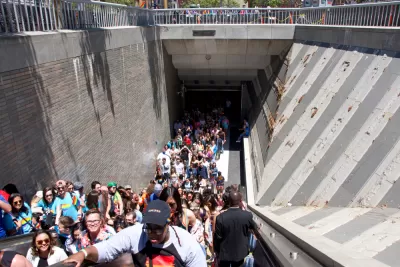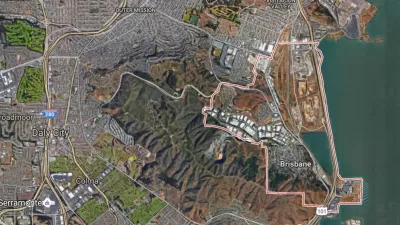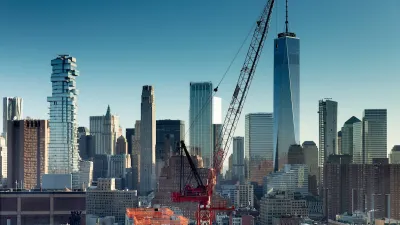Transportation and land use are being considered together at a new scale in the Bay Area, as transit oriented development pops up next to BART stations all over the region.

John King surveys the San Francisco Bay Area for examples of the transit-oriented building spree taking place near BART stations, like at MacArthur Station in Oakland:
A seven-story building with lime-green accents covers land that five years ago held parking lots. It’s part of a 385-unit apartment complex being marketed as “sleek and modern with a retro vibe ... perfect for your life on the go.” A few yards away, workers have nearly completed the concrete frame for a 24-story apartment tower that will open next spring.
In a feature story filed under "Bay Area Housing Crisis," King reports that projects have opened recently at seven East Bay BART stations, and projects at three more that could break ground soon. "Cities across the system are putting plans in place to allow bigger buildings near BART," writes King.
"Long touted by boosters as pedestrian-friendly 'transit villages,' such projects on BART-owned land are gaining traction as never before. The change is fueled by factors including the region’s incessant housing demand and a new state law that loosens development restrictions on BART property."
The idea of adding large buildings and large amounts of housing units to BART-adjacent properties has been occasionally controversial, but the recent development activity acts on planning goals set as long ago as 1972, and formalized by a formalized planning policy in 2005.
"The current policy, adopted in 2016, seeks to add up to 18,000 units by 2040, filling 250 acres at 27 stations," according to King. "It also sets a goal that 35% of these units should be reserved for below-market housing."
There is a lot more to see and consider in this big feature, with infographics, images, and soundbites that match the scale of the endeavor underway in the Bay Area.
FULL STORY: At home at BART

Alabama: Trump Terminates Settlements for Black Communities Harmed By Raw Sewage
Trump deemed the landmark civil rights agreement “illegal DEI and environmental justice policy.”

Planetizen Federal Action Tracker
A weekly monitor of how Trump’s orders and actions are impacting planners and planning in America.

The 120 Year Old Tiny Home Villages That Sheltered San Francisco’s Earthquake Refugees
More than a century ago, San Francisco mobilized to house thousands of residents displaced by the 1906 earthquake. Could their strategy offer a model for the present?

In Both Crashes and Crime, Public Transportation is Far Safer than Driving
Contrary to popular assumptions, public transportation has far lower crash and crime rates than automobile travel. For safer communities, improve and encourage transit travel.

Report: Zoning Reforms Should Complement Nashville’s Ambitious Transit Plan
Without reform, restrictive zoning codes will limit the impact of the city’s planned transit expansion and could exclude some of the residents who depend on transit the most.

Judge Orders Release of Frozen IRA, IIJA Funding
The decision is a victory for environmental groups who charged that freezing funds for critical infrastructure and disaster response programs caused “real and irreparable harm” to communities.
Urban Design for Planners 1: Software Tools
This six-course series explores essential urban design concepts using open source software and equips planners with the tools they need to participate fully in the urban design process.
Planning for Universal Design
Learn the tools for implementing Universal Design in planning regulations.
Clanton & Associates, Inc.
Jessamine County Fiscal Court
Institute for Housing and Urban Development Studies (IHS)
City of Grandview
Harvard GSD Executive Education
Toledo-Lucas County Plan Commissions
Salt Lake City
NYU Wagner Graduate School of Public Service





























